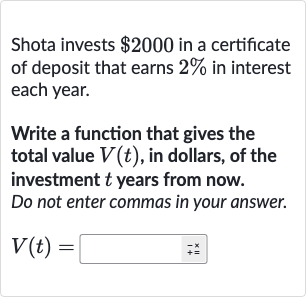Full solution
Q. Shota invests in a certificate of deposit that earns in interest each year.Write a function that gives the total value , in dollars, of the investment years from now.Do not enter commas in your answer.
- Identify Interest Type: Identify the type of interest being calculated.Since the problem states that the investment earns in interest each year, this suggests that the interest is compounded annually.
- Write Compound Interest Formula: Write the formula for compound interest.The formula for compound interest is , where is the principal amount, is the annual interest rate, is the number of times the interest is compounded per year, and is the number of years.
- Plug in Values: Plug in the values into the formula.Since the interest is compounded annually, . The principal is , the annual interest rate is or , and is the number of years. So the formula becomes .
- Simplify the Formula: Simplify the formula.This is the function that gives the total value of the investment years from now.
More problems from Write exponential functions: word problems
QuestionGet tutor help
QuestionGet tutor help
QuestionGet tutor help
QuestionGet tutor help
QuestionGet tutor help
QuestionGet tutor help

